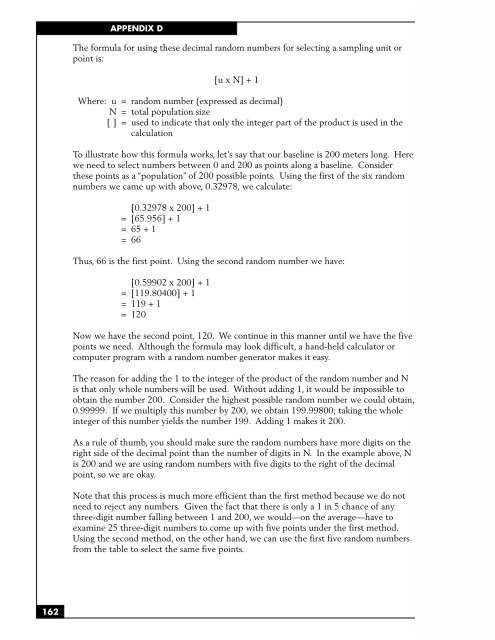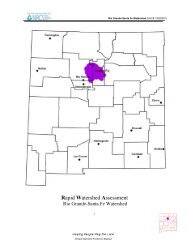SAMPLING VEGETATION ATTRIBUTES - New Mexico NRCS - US ...
SAMPLING VEGETATION ATTRIBUTES - New Mexico NRCS - US ...
SAMPLING VEGETATION ATTRIBUTES - New Mexico NRCS - US ...
Create successful ePaper yourself
Turn your PDF publications into a flip-book with our unique Google optimized e-Paper software.
162<br />
APPENDIX D<br />
The formula for using these decimal random numbers for selecting a sampling unit or<br />
point is:<br />
[u x N] + 1<br />
Where: u = random number (expressed as decimal)<br />
N = total population size<br />
[ ] = used to indicate that only the integer part of the product is used in the<br />
calculation<br />
To illustrate how this formula works, let’s say that our baseline is 200 meters long. Here<br />
we need to select numbers between 0 and 200 as points along a baseline. Consider<br />
these points as a “population” of 200 possible points. Using the first of the six random<br />
numbers we came up with above, 0.32978, we calculate:<br />
[0.32978 x 200] + 1<br />
= [65.956] + 1<br />
= 65 + 1<br />
= 66<br />
Thus, 66 is the first point. Using the second random number we have:<br />
[0.59902 x 200] + 1<br />
= [119.80400] + 1<br />
= 119 + 1<br />
= 120<br />
Now we have the second point, 120. We continue in this manner until we have the five<br />
points we need. Although the formula may look difficult, a hand-held calculator or<br />
computer program with a random number generator makes it easy.<br />
The reason for adding the 1 to the integer of the product of the random number and N<br />
is that only whole numbers will be used. Without adding 1, it would be impossible to<br />
obtain the number 200. Consider the highest possible random number we could obtain,<br />
0.99999. If we multiply this number by 200, we obtain 199.99800; taking the whole<br />
integer of this number yields the number 199. Adding 1 makes it 200.<br />
As a rule of thumb, you should make sure the random numbers have more digits on the<br />
right side of the decimal point than the number of digits in N. In the example above, N<br />
is 200 and we are using random numbers with five digits to the right of the decimal<br />
point, so we are okay.<br />
Note that this process is much more efficient than the first method because we do not<br />
need to reject any numbers. Given the fact that there is only a 1 in 5 chance of any<br />
three-digit number falling between 1 and 200, we would—on the average—have to<br />
examine 25 three-digit numbers to come up with five points under the first method.<br />
Using the second method, on the other hand, we can use the first five random numbers<br />
from the table to select the same five points.




